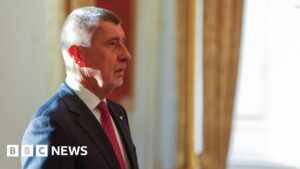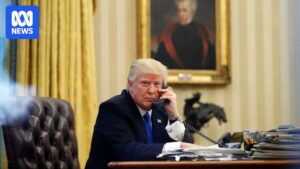
US President Donald Trump has ignited a storm of controversy in Ukraine with a proposed peace plan that suggests halving the Ukrainian military and ceding territory to Russia. This proposal comes as the US intensifies oil sanctions against Moscow, aiming to cut off critical revenue streams.
Trump’s peace proposal was sent to Ukrainian President Volodymyr Zelensky ahead of anticipated talks, despite strong objections from Kyiv. Ukrainian political leaders are advocating for a more robust stance against the Kremlin, arguing that pressure on Russia is yielding results.
Ukrainian Response to the US Proposal
Ukrainian Prime Minister Yulia Svyrydenko has voiced her opposition to the US plan, asserting that existing measures against Russia are effective and should be intensified. “While Russia continues killing innocent civilians, destroying homes, and targeting critical infrastructure, the strategy of pressure on Russia is proving effective,” she stated.
Svyrydenko’s remarks followed a meeting with US Army Secretary Dan Driscoll in Kyiv. Zelensky also confirmed his engagement with Driscoll, expressing a willingness to discuss the US plan. “Our teams – Ukraine and the USA – will work on the points of the plan to end the war,” Zelensky announced via Telegram.
Details of the Controversial Peace Plan
The American plan reportedly includes 28 points, notably proposing that Ukraine relinquish land in the Donbas region, some of which is currently under Ukrainian control. Additionally, the plan suggests a significant reduction of Ukraine’s defense forces and the cessation of long-range missile usage.
While the proposal includes an American security guarantee, Ukrainian leaders have rejected the notion of diminishing their military capabilities, fearing increased vulnerability to future Russian aggression. Oleksandr Merezhko, head of Ukraine’s foreign affairs committee, criticized the plan as “absolutely senseless.”
“We are ready now, as before, to work constructively with the American side, as well as with our partners in Europe and around the world so that the outcome is peace,” stated Zelensky’s office.
International Reactions and Ongoing Conflict
European Commission foreign policy chief Kaja Kallas has welcomed the US effort to broker peace but highlighted recent Russian attacks as evidence of Moscow’s lack of commitment to peace. “For any plan to work, it needs the Ukrainians and Europeans on board,” she emphasized.
The peace plan’s emergence follows a devastating night of Russian aggression, with 476 drones and 48 missiles launched at Ukraine, resulting in 26 deaths and approximately 100 injuries. The attack underscores the ongoing volatility in the region.
Meanwhile, the US has implemented tougher sanctions on Russian oil exports, targeting major suppliers Lukoil and Rosneft. These measures, set to take full effect soon, are already impacting Russia’s oil revenue as global buyers reduce their reliance on Russian oil.
Historical Context and Future Implications
This controversial peace initiative comes three weeks after Trump’s special envoy, Steve Witkoff, held discussions with senior Russian official Kirill Dmitriev in Florida. Despite these talks, Kremlin spokesman Dmitry Peskov has denied any ongoing consultations.
The proposed peace plan and intensified sanctions reflect a complex geopolitical landscape, where diplomatic efforts are intertwined with economic pressures. As the situation unfolds, the international community watches closely, understanding that any resolution must address both Ukrainian sovereignty and regional stability.
As discussions continue, the world awaits further developments, recognizing that the path to peace in Ukraine remains fraught with challenges and geopolitical intricacies.






